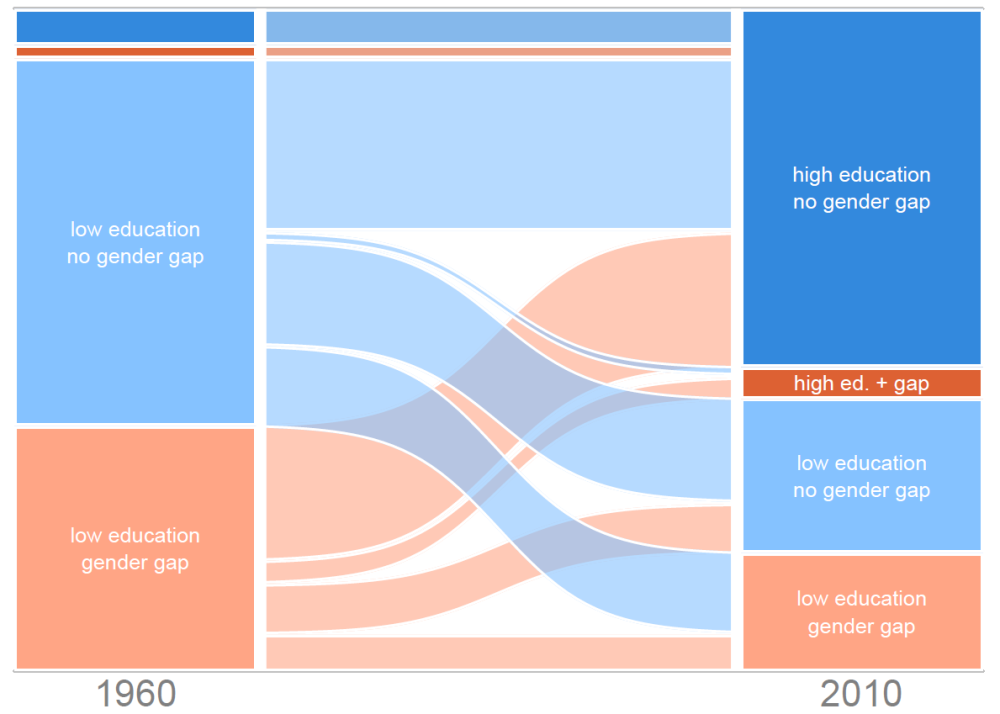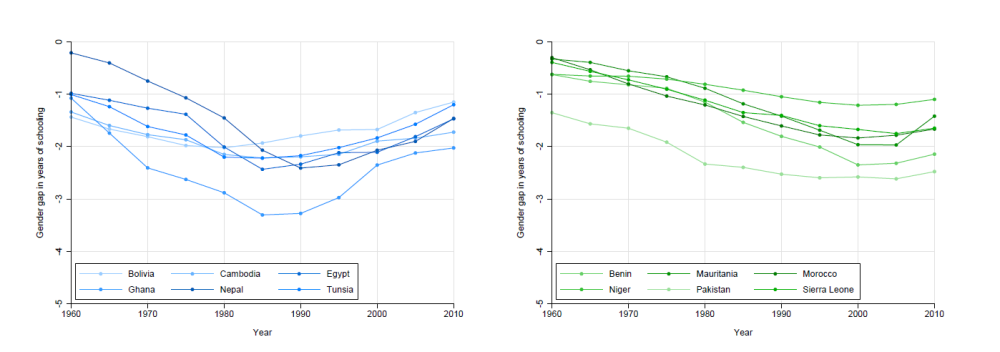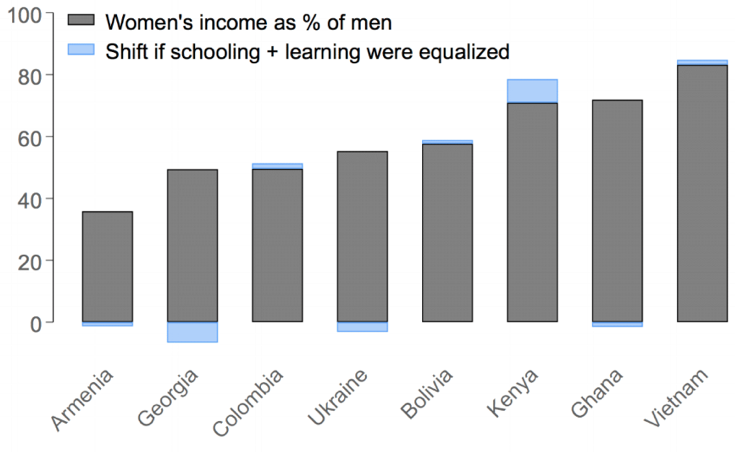Recommended
Read the CGD working paper here.
Girls' education is heralded as one of the most cost-effective investments in global development by donors, Hollywood A-listers, and even British Prime Ministerial hopefuls not known for their love of foreign aid. And with good reason. Gender gaps in schooling attainment have declined over the last century but many countries are still far from achieving gender equality in the classroom.
To explore this topic, we took a deep dive into the Barro-Lee Educational Attainment Data. The Barro-Lee data are useful for this purpose because they cover 146 countries—including many low- and middle-income countries—over the fifty years from 1960 to 2010. This allows us to place current trends and averages in historical context and to get a sense of how much progress has been made toward achieving gender equality -- including which countries have outperformed the average and where progress has stalled or reversed.
So, what do these data tell us about gender gaps in education, and where we should be focusing our research, policy, and programmatic efforts to address gender inequality?
Fact 1: Worldwide, women are more educated today than at any point in history, but we are still not as educated as men
Sixty years ago, almost 50 percent of women had no formal schooling and their average level of educational attainment was just 3.3 years. By 2010, only a fifth of adult women had no formal schooling and their average attainment had increased to 7.7 years. This is great progress.
In fact, both girls and boys are getting much more education today than they were 60 years ago. The average level of education among adult men was 4.1 years in 1960 and more than double that—8.6 years—in 2010. The share of men with no formal education dropped from 37 percent to 10 percent over the same period.
Figure 1: Country level changes in educational attainment

Source: authors’ analysis of Barro-Lee data
Figure 1 shows the trajectory of male and female educational attainment in each of the 146 countries included in the Barro-Lee Educational Attainment data set. Most countries have more or less moved up the 45-degree line, representing equal improvements for men and women. This is slightly less true for South Asian nations but generally true for African countries . Countries where gender gaps increased substantially—India, Afghanistan and Togo, for example—over the last 60 years are the exception rather than the rule.
Figure 2: Country level changes in schooling: levels and gaps

Source: authors’ analysis of Barro-Lee data
Figure 2 provides more color on the evolution of these patterns. Women's educational attainment has increased in every single country in the Barro-Lee data set. Across countries, the median level of (average) educational attainment among women has gone from two years to eight years. But when we turn to gender gaps, the picture is more complex. Between 1960 and 2010, gender gaps reduced in 104 countries but widened in 42 countries. Many of the largest declines occurred in the Middle East and North Africa: Kuwait, Libya, Qatar, Saudi Arabia, and the United Arab Emirates all saw the gender gap in attainment decline by more than two years. Not surprisingly, the countries that saw the largest increases in the gender gap—Afghanistan, Benin, CAR, Haiti, Liberia, India, Togo, and Yemen—still have large gender gaps today. The median gender gap was 1.2 years in 1960, and it only reduced by a third over the next fifty years to 0.8 years. Women are much more educated today than we were, but we are still quite a lot less educated than men.
Fact 2: Gender gaps rarely persist in educated countries
Some welcome news is that countries where men are highly educated and women are not highly educated are rare. To examine how gender gaps change as countries got more educated (or not) over time, we classified countries according to the average level of education among men (above eight years of schooling is “high education” and below is “low education”); and the gender gap in attainment (an average level of schooling among women of more than a year lower than men is “gender gap” and less than a year is “no (small) gender gap”).
Figure 3: Persistence of gender gaps in high- and low-educated countries

Source: authors’ analysis of Barro -Lee data
Figure 3 tells us that “high education” countries are far more common in 2010 than in 1960 and almost all high education countries have small gender gaps in attainment. In other words, countries with high levels of education among men almost never have substantial gender gaps. This was true in 1960 and it is true today. In fact, in 2010 there were only seven countries where men had more than eight years of schooling and women had more than one year less schooling than men -- Austria, Bolivia, Ghana, Iraq, South Korea, Luxembourg, and Tunisia.
On the other hand, countries with “low education” show more variation. Gender gaps narrowed in some places and widened in others. Gender gaps have developed in some low-education countries where they did not exist before, but disappeared or diminished elsewhere.
We’re talking about girls’ education, but it’s important to remember that countries with gender gaps tend to be the same countries where boys are also getting a lousy education. If a lot of girls are out-of-school, lots of boys are too. And those boys and girls who are out-of-school are likely to be very poor. To address inequity we should tackle gender gaps as part of an agenda that also tackles educational opportunities for disadvantaged boys. Programs must address the specific constraints faced by girls, but also acknowledge the fact that in almost every country where girls are lagging behind, the educational prospects for poor and vulnerable boys are also dismal.
Fact 3: Gender gaps often get worse before they get better
Our analysis of the Barro-Lee data shows that the gender gap trajectory does not follow a smooth path. Indeed, in many countries, gaps widen substantially before they start to close This is true in individual nations, but is is also true in aggregate in the three regions that had particularly low levels of educational attainment in 1960: the Middle East and North Africa, South Asia, and sub-Saharan Africa.
Figure 4: Gender gaps get worse before they get better

Source: authors’ analysis of Barro-Lee data
Between 1960 and 1985, the gender gap increased substantially in these regions, while regions with higher levels of attainment in 1960 experienced small increases or small decreases between 1960 and 1985. By 1985, the tide had turned and in every region of the world gender gaps started to shrink. Although, in some places the narrowing was not enough to undo the gap that took place during the preceding decades.
How do we explain this widening of gender gaps as overall education levels increase? Well, more kids are going to school but they don’t go evenly. As educational opportunities first become available to poor households, boys often get sent to school first while girls stay at home. This “vertical convergence’’ sees gender gaps diminishing within wealthy household but getting larger among the poor (Psaki, McCarthy, and Mensch 2018; Eloundou-Enyegue, Makki, and Giroux 2009), a trend that explains the pattern observed in many countries with low attainment 60 years ago. In other words, gender gaps widened as more boys went to school and eventually narrowed as their sisters started to enrol too.
Looking at Facts 2 and 3 together provides some insights into the patterns we observe among the 33 countries that still had substantial gender gaps in educational attainment in 2010.
First, many are fragile and conflict-affected states -- Afghanistan, the Democratic Republic of Congo, Sudan, Syria, and Yemen, for example. These are countries where children have limited educational opportunities and where governments and communities are facing acute challenges far beyond the education sector.
Second, in another set of countries—Cambodia, Egypt, Ghana, and Nepal, for example—there is evidence of the “it gets worse before it gets better” pattern. Figure 5 shows these countries on the left, with the gender gap widening between the 1960s and 1980s but narrowing since then. They are now on a trajectory that suggests that the gender gap in attainment should effectively disappear by 2030. While the story isn't as clear cut in the group of countries on the right, the signs are there that the gap is starting to narrow.
Figure 5: Gender gaps are narrowing in peaceful countries

Source: authors’ analysis of Barro-Lee data
Of course “things get worse before they get better” does not mean gender gaps go away on their own. Progress reflected in the graphs in Figure 5 represent a tremendous amount of advocacy and effort. The good news is that—in most places—this effort seems to be paying off.
Fact 4: Test scores don’t tell us enough about gender gaps
As gender gaps in attainment reduce, attention should turn to other ways that girls and young women may be disadvantaged inside and outside the classroom. Girls face discrimination and stereotyping by teachers, exposure to gender-based violence at school, exclusion from school due to pregnancy or early marriage, and a greater burden of chores at home. And then there is the “learning gap,” which is where much of the current effort is directed. Even when girls attend school, they may not learn as much—perhaps because they are absent more often, they are hungrier, they have to expend effort to avoid unwanted attention from their teachers, or they have less time for homework.
Measuring these types of learning gaps is challenging from a statistical perspective, particularly in environments where gender gaps in enrolment persist. Interpreting differences in levels of academic performance—for example through comparing test scores—as learning gaps implicitly assumes that the population of male and female students is comparable in terms of their ability entering the classroom. Take an average 4th grade test score. In the presence of enrollment gaps, differences in performance in this test can't be interpreted as a gender learning gap unless we use statistical techniques to account for selection in terms of who enrolls in school. Unfortunately, we can't just look at literacy levels among men and women in the entire population either—at least not while more boys are attending school. Without using statistical techniques for bounding we can't say anything about gaps in learning or achievement until gender gaps in attainment are eliminated.
Moreover, even after gender gaps in attainment disappear, it is important to remember that learning is a change and not a level. Girls and boys may arrive at school with different levels of preparedness. We can make credible statements about learning gaps when we compare changes in gender gaps over time—i.e. across two different grade levels—and adjust for differential selection into school (see, for example, Carneiro, Cruz-Aguayo, and Schady 2017). But simple comparisons of academic performance among enrolled students tell us very little about the presence or absence of gender gaps in learning.
Fact 5: Gender equality in education is not enough
Eliminating gender gaps in education does not produce equal life outcomes for women. Even in countries where schools are achieving gender equity in enrollment and in learning, women’s adult outcomes once they leave school—in the labor market, in politics, and even in their households—remain woefully unequal. Gender inequality remains acute and deeply rooted in the economic, political, and social spheres. The chart below shows that the gap in earnings power between men and women is enormous in many parts of the developing world and—significantly—that the gap would not shift drastically even if attainment and learning were equalized. Gender parity in education may be a necessary condition for empowerment, but it is certainly not a sufficient condition.
Figure 6: Schooling and learning can’t seem to explain the gender earnings gap

Source: Source: CGD analysis of World Bank STEP surveys from urban labor markets, based on Oaxaca-Blinder decomposition. Note: Individuals who do not work are assigned zero income
The gender pay gap doesn’t reduce much if education is equalized, but surely more women enter the labor market? Well, not so much. Figure 7 shows that there is essentially no relationship between changes in the gender gap in education and the gender gap in labor force participation. Gender gaps in labor force participation have reduced substantially over time. Gender gaps in schooling have reduced too (although not by quite as much). But, closing gender gaps in educational attainment does not close the gap in labor force participation.
Figure 7: Gender equality in education versus labor force participation

Source: Jakiela and Ozier, 2019
Labor force participation is an important marker of women's participation in economic life. We know it is constrained by social norms, insecurity, a lack of access to capital, a lack of reasonable childcare—the list goes on. If we want to equalize women's opportunities, it is not enough to equalize educational outcomes and hope that the market does the rest. We need to work to ensure that women have the same opportunities as men to use their human capital once they leave school. And within schools, it may not be enough to strive for equal attainment and learning. If we think education is a tool for girls empowerment, we need to understand why seemingly equal education is compatible with such unequal outcomes, and what more education systems can do to help combat inequality outside school.
Thanks to Maryam Akmal for assistance creating beautiful figures.
Interested in more? Read the CGD working paper by David Evans, Pamela Jakiela, and Maryam Akmal here.
Disclaimer
CGD blog posts reflect the views of the authors, drawing on prior research and experience in their areas of expertise. CGD is a nonpartisan, independent organization and does not take institutional positions.





